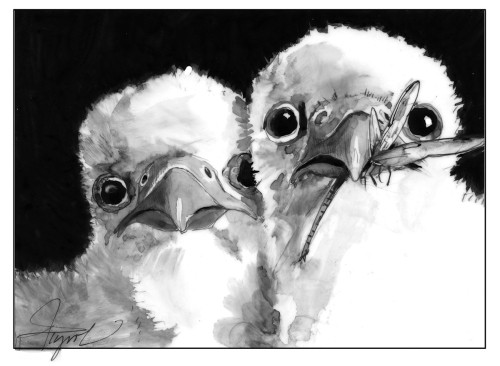
There is a broad, craggy precipice in Franconia Notch, not far from my home, called Eagle Cliff. It was named in the 1800s for the golden eagles that nested there, back when the region was full of open farmland that was conducive to the giant raptors’ lifestyle. While the fields have grown up and the eagles are long gone, the cliff has been home to nesting peregrine falcons each year since 1981.
Once completely absent from the eastern United States, peregrine falcons have been making a steady comeback since the 1980s. Those falcons that nested on Eagle Cliff in 1981 marked the first successful re-occupancy of a historic cliff breeding site. Since then, recolonization has been steady, if slow.
“The population hasn’t been growing very rapidly,” said Chris Martin, a senior biologist with New Hampshire Audubon and director of that agency’s Peregrine Falcon Monitoring and Management Program. “Peregrines are just inching up. If we find a new nest site in a year, that’s a good year.”
There have been lots of good years since that first pair of falcons fledged two chicks in 1981. Last year, for example, New Hampshire Audubon staff – in collaboration with the state’s Fish & Game Department – documented 17 nesting pairs of peregrine falcons and 43 chicks. The numbers are rising similarly in Vermont, where a single pair of peregrine falcons fledged two chicks in 1986; by 2017, there were 44 documented nesting pairs raising 63 chicks.
Although removed from the federal Endangered Species List in 1999, peregrine falcons are still categorized as endangered in Maine and New York and as threatened in New Hampshire. Vermont has upgraded peregrines to recovered status.
These crow-sized raptors are best known for their speed. In regular flight, a peregrine falcon can accelerate from around 25 miles per hour to close to 70 miles per hour while pursuing prey. They can go even faster when performing a dive-bombing-style “stoop,” reaching speeds upwards of 200 miles per hour while zeroing in on a chickadee or woodpecker or small duck.
“They’ll pull their wings in and look like a torpedo or a bullet dropping through the air,” said Martin.
The small raptors are able to slightly dislocate the shoulder joints of their wings to obtain a more streamlined shape. A bony structure at the opening of each nostril deflects air when the falcon is in a stoop so its lungs don’t overfill. Peregrine falcons also have incredible eyesight, allowing them to track prey at long distances.
All of this allows falcons to surprise and kill their prey efficiently. Peregrine falcons can chase and catch other birds, but they often strike their quarry with a killing blow in mid-air. The adults teach chicks to hunt by dropping food for the young birds to practice catching. Peregrine chicks will also snag dragonflies – a slightly easier target than songbirds – while learning to hunt.
These skillful flyers were decimated in the mid-twentieth century, in large part due to widespread use of the insecticide DDT. The chemical caused their eggs – and the eggs of other top-of-the-foodchain raptors – to become thin-shelled, which meant they either broke during incubation or failed to hatch.
The chemical was banned in 1972. In cooperation with other agencies, the U.S. Fish & Wildlife Service started peregrine recovery efforts in the late 1970s, when chicks were hatched in captivity and released into the wild.
As peregrine falcons have gradually recovered in the Northeast, participating agencies have worked to protect natural nesting sites and enhance new sites on manmade structures. Peregrine falcons typically choose sites on high cliffs, and a pair will return each year to the same area, building a small scrape for laying eggs – or using a repurposed raven’s nest. But biologists have also encouraged nesting on manmade structures – tall buildings, smoke stacks, and bridges – by adding nesting boxes when peregrines are known to be in the area. One such site is the 259-foot tall Brady Sullivan building in Manchester, New Hampshire, where New Hampshire Audubon has set up a peregrine web cam and where falcons have been nesting since 2001.
Still, Martin said about 80 percent of the peregrine falcons in New Hampshire nest on cliff faces, including many locations around the White Mountains and along the Connecticut River. “One of the things that’s unique about northern New England’s peregrines is the vast majority of our birds are still nesting in ancestral, natural habitats,” said Martin. “They’re using the same places they used 100 years ago. These birds are back where they were – plus some other places, too.”


Discussion *